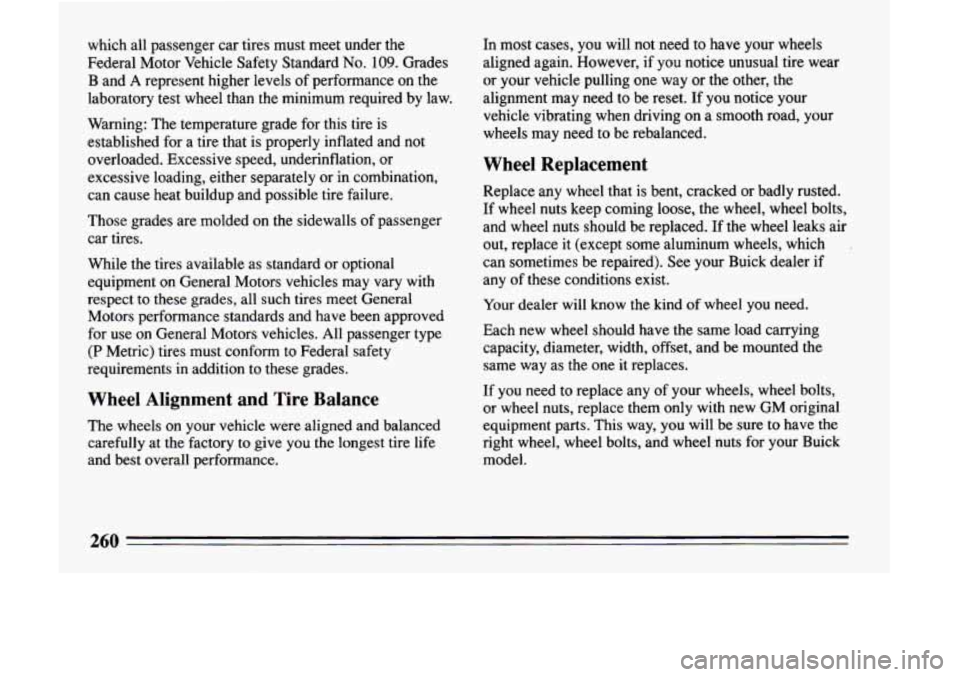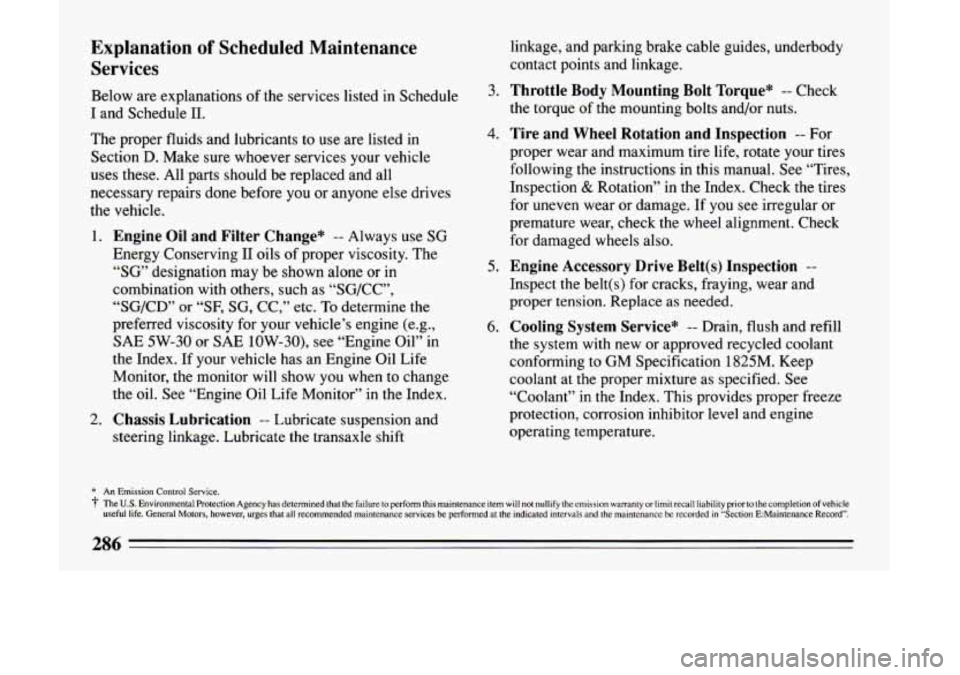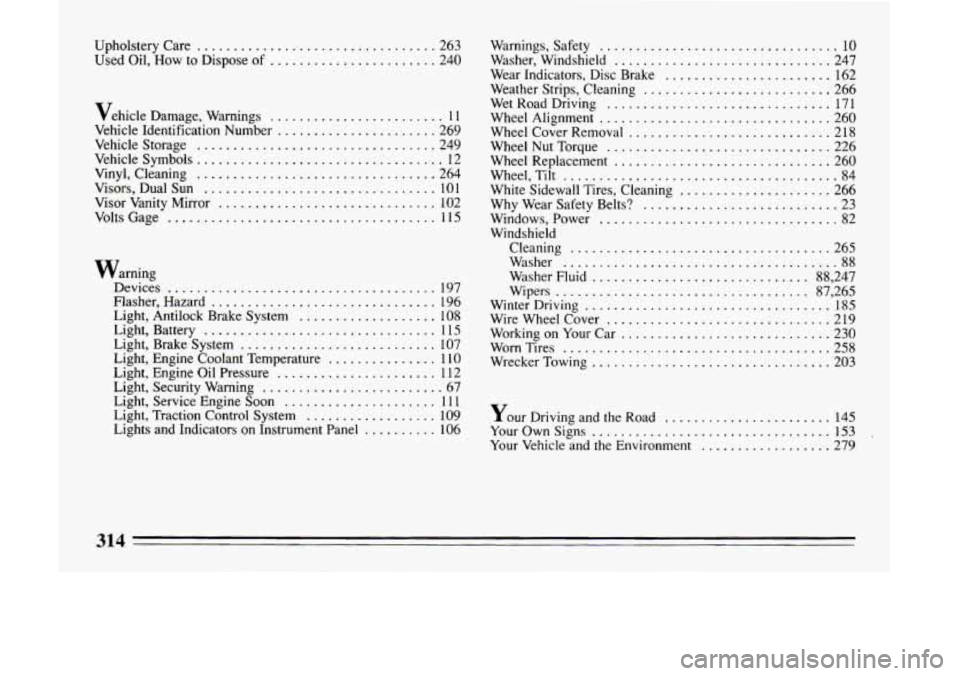1993 BUICK LESABRE wheel alignment
[x] Cancel search: wheel alignmentPage 262 of 324

which all passenger car tires must meet under the
Federal Motor Vehicle Safety Standard
No. 109. Grades
B and
A represent higher levels of performance on the
laboratory test wheel than the minimum required by law.
Warning: The temperature grade for this tire is
established for a tire that is properly inflated and not
overloaded. Excessive speed, underinflation, or
excessive loading, either separately or in combination,
can cause heat buildup and possible tire failure.
Those grades are molded on the sidewalls of passenger
car tires.
While the tires available as standard or optional
equipment on General Motors vehicles may vary with respect to these grades, all such tires meet General
Motors performance standards and have been approved
for use on General Motors vehicles. All passenger type
(P Metric) tires must conform to Federal safety
requirements in addition to these grades.
Wheel Alignment and Tire Balance
The wheels on your vehicle were aligned and balanced
carefully at
the factory to give you the longest tire life
and best overall performance. In most cases, you will not need
to have your wheels
aligned again. However, if you notice unusual tire wear
or your vehicle pulling one way or the other, the
alignment may need to be reset.
If you notice your
vehicle vibrating when driving on a smooth road, your
wheels may need
to be rebalanced.
Wheel Replacement
Replace any wheel that is bent, cracked or badly rusted.
If wheel nuts keep coming loose, the wheel, wheel bolts,
and wheel nuts should be replaced.
If the wheel leaks air
out, replace it (except some aluminum wheels, which
can sometimes be repaired). See your Buick dealer if
any
of these conditions exist.
Your dealer
will know the kind of wheel you need.
Each new wheel should have the same load carrying
capacity, diameter, width, offset, and be mounted the
same way as
the one it replaces.
If you need to replace any of your wheels, wheel bolts, or wheel nuts, replace them only with new GM original
equipment
parts. This way, you will be sure to have the
right wheel, wheel bolts, and wheel nuts for your Buick model.
260
Page 288 of 324

Explanation of Scheduled Maintenance
Services
Below are explanations of the services listed in Schedule
I and Schedule 11.
The proper fluids and lubricants to use are listed in
Section
D. Make sure whoever services your vehicle
uses these. All parts should be replaced and all
necessary repairs done before
you or anyone else drives
the vehicle.
1. Engine Oil and Filter Change* -- Always use SG
Energy Conserving I1 oils of proper viscosity. The
“SG” designation may be shown alone or in
combination with others, such as “SG/CC”,
“SG/CD” or “SF, SG, CC,” etc. To determine the
preferred viscosity for your vehicle’s engine (e.g.,
SAE
5W-30 or SAE 10W-30), see “Engine Oil” in
the Index. If your vehicle has an Engine Oil Life
Monitor, the monitor will show
you when to change
the oil. See “Engine Oil Life Monitor” in the Index.
2. Chassis Lubrication -- Lubricate suspension and
steering linkage. Lubricate the transaxle shift linkage, and parking brake
cable guides, underbody
contact points and linkage.
3. Throttle Body Mounting Bolt Torque* -- Check
the torque of the mounting bolts and/or nuts.
4. Tire and Wheel Rotation and Inspection -- For
proper wear and maximum tire life, rotate your tires
following
the instructions in this manual. See “Tires,
Inspection
& Rotation” in the Index. Check the tires
for uneven wear or damage. If you see irregular or
premature wear, check the wheel alignment. Check
for damaged wheels also.
5. Engine Accessory Drive Belt(s) Inspection --
Inspect the belt(s) for cracks, fraying, wear and
proper tension. Replace as needed.
6. Cooling System Service” -- Drain, flush and refill
the system with new or approved recycled coolant
conforming to GM Specification 1825M. Keep
coolant at the proper mixture as specified. See
“Coolant” in
the Index. This provides proper freeze
protection, corrosion inhibitor level
and engine
operating temperature.
* An Emission Control Service.
3‘ The U.S. Environmental Protection Agency has determined that the failure to perfonn this maintenance item will not nullify the emission warranty or limit recall liability prior to thecompletion of vehicle
useful life. General Motors, however, urges that all recommended maintenance services be performed at the indicated intervals and the maintenance be recorded in “Section E:Maintenance Record”.
286
Page 316 of 324

Upholstery Care ................................. 263
Used Oil. How to Dispose
of ....................... 240
Vehicle Damage. Warnings
........................ 1 1
Vehicle Identification Number
...................... 269
Vehicle Storage
................................. 249
Vehicle Symbols
.................................. 12
Vinyl. Cleaning
................................. 264
Visors. Dual
Sun ................................ 10 1
Visor Vanity Mirror .............................. 102
Volts Gage
..................................... 11 5
Warning
Devices
..................................... 197
Flasher. Hazard
............................... 196
Light. Antilock Brake System
................... 108
Light. Battery
................................ 1 15
Light. Brake System
........................... 107
Light. Engine Oil Pressure
...................... 1 12
Light. Security Warning
......................... 67
Light.
Engine Coolant Temperature
............... 11 0
Light. Service Engine Soon ..................... 11 1
Light. Traction Control System
.................. 109
Lights and Indicators
on Instrument Panel .......... 106 Warnings. Safety
................................. 10
Washer. Windshield .............................. 247
Wear Indicators. Disc Brake
....................... 162
Weather Strips. Cleaning
.......................... 266
Wet Road Driving
............................... 171
Wheel Alignment
................................ 260
Wheel Cover Removal
............................ 218
WheelNutTorque
............................... 226
Wheel Replacement
.............................. 260
Wheel. Tilt ...................................... 84
White Sidewall Tires. Cleaning
..................... 266
Why Wear Safety Belts?
............................ 23
Windows. Power
................................. 82
Cleaning .................................... 265
Washer
...................................... 88
Washer Fluid
.............................. 88. 247
Wipers
................................... 87. 265
Winter Driving
.................................. 185
Wire Wheel Cover
............................... 219
Working on Your Car
............................. 230
Worn Tires
..................................... 258
WreckerTowing
................................. 203
Windshield
Your Driving and the Road ....................... 145
Your Own Signs
................................. 153
Your Vehicle and the Environment .................. 279
314